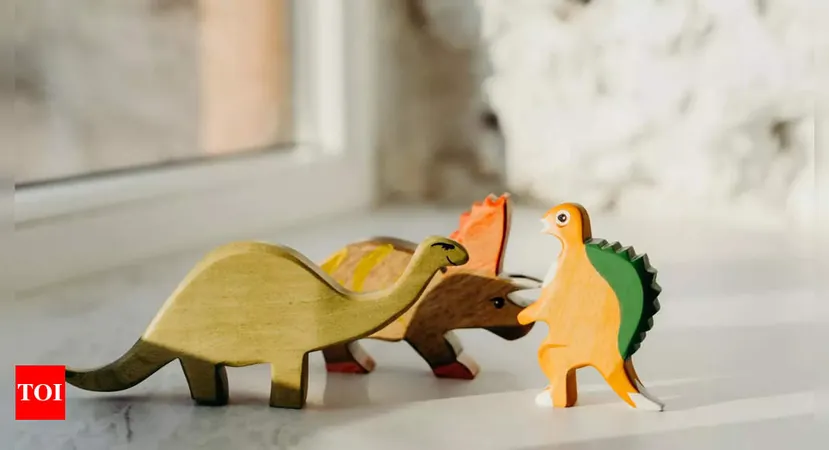
Fossilized Dung Uncovers the Secrets Behind Dinosaur Domination on Earth
2024-11-28
Author: Jacques
Groundbreaking Discoveries in Dinosaur Evolution
Scientists have made groundbreaking discoveries about why dinosaurs took approximately 30 million years to dominate Earth by meticulously studying fossilized feces, commonly known as coprolites. These ancient leftovers, which contain undigested food and remnants of their prey, reveal that the dinosaurs’ dietary diversity and adaptability played a pivotal role in their evolutionary triumph during the Late Triassic epoch.
The Mystery of Dinosaur Ascendance
Dinosaurs, the colossal reptiles that once roamed the planet, have long fascinated researchers and the public alike. The mystery surrounding their lengthy ascent to apex predators has perplexed scientists for decades. However, a recent study has teased apart this enigma, demonstrating that the contents of fossilized dung hold critical key insights into the dietary habits that fueled dinosaur dominance.
A Seminal Study in Nature
The seminal study, published in the esteemed journal *Nature*, involved extensive analysis of coprolites and bromalites—essentially fossilized poop and vomit. “Piecing together ‘who ate whom’ from the past is like detective work,” remarked Martin Qvarnström, a researcher at the Department of Organismal Biology and lead author of the study. He emphasized that investigating the diets of these ancient creatures sheds light on their interactions with their ecosystems, ultimately clarifying the secrets behind their success.
Collaborative Research Efforts
Collaborating with paleontologists from Uppsala University, along with teams from Norway, Poland, and Hungary, researchers employed advanced synchrotron imaging technology to scrutinize hundreds of coprolites. This refined analysis unveiled compelling insights about the diets of early dinosaurs, highlighting the types of plants and animals that were consumed.
Reconstructing the Late Triassic Ecosystem
By piecing together undigested food remains, these scientists reconstructed the ecological landscape of the Late Triassic period, a time when dinosaurs began to thrive in what was then the northern supercontinent Pangea. Their research combined coprolite data with climatic conditions and an array of other fossils, including plant remains and bone fragments, constructing a nuanced picture of the ecosystems over 230 to 200 million years ago.
A 25-Year Endeavor
The endeavor spanned 25 years, as explained by Grzegorz Niedźwiedzki, a researcher at Uppsala University and senior author of the study. “Our research stands out because we aimed to understand the biology of early dinosaurs through their dietary patterns. The discoveries we made along this journey were genuinely unexpected.”
Fossilized Dietary Insights
Among the materials studied, the fossilized dung revealed remains of fish, insects, and larger animals, with impressive preservation levels, including small beetles and well-preserved fish. Some samples contained crushed bones that suggested predatory behavior akin to that of modern hyenas, which use bones to extract salts and marrow.
Herbivores and Their Diets
Perhaps most fascinating was the analysis of coprolites from early large herbivorous dinosaurs, such as the long-necked sauropods. Researchers found significant quantities of tree ferns and various other plants in their dung, with some samples even containing charcoal. This prompted scientists to hypothesize that early herbivores may have consumed charcoal to mitigate the toxic effects of certain fern species.
Addressing the Evolutionary Gap
This research also addressed a critical gap in the understanding of the first 30 million years of dinosaur evolution during the Late Triassic period. The findings suggest that dietary diversity and the ability to adapt to changing environments were crucial traits that enabled these giants to survive amidst shifting ecological landscapes.
Lessons for Today
As Qvarnström pointed out, the lessons from the past are especially relevant today: "We can learn how life adjusts and flourishes in changing conditions." With the world facing climate change and biodiversity loss, understanding how these ancient creatures thrived can provide valuable insights into resilience in the face of environmental obstacles.
Conclusion and Advice from the Past
Niedźwiedzki concluded with a humorous yet poignant remark, “The key to avoiding extinction? Eat a lot of plants—just as the early herbivorous dinosaurs did, thriving on their love of green, fresh shoots.”
Continued Exploration of Dinosaur Mysteries
The mysteries of these gigantic creatures continue to unravel, reminding us of the vast and intricate histories that shape life on Earth today.









 Brasil (PT)
Brasil (PT)
 Canada (EN)
Canada (EN)
 Chile (ES)
Chile (ES)
 España (ES)
España (ES)
 France (FR)
France (FR)
 Hong Kong (EN)
Hong Kong (EN)
 Italia (IT)
Italia (IT)
 日本 (JA)
日本 (JA)
 Magyarország (HU)
Magyarország (HU)
 Norge (NO)
Norge (NO)
 Polska (PL)
Polska (PL)
 Schweiz (DE)
Schweiz (DE)
 Singapore (EN)
Singapore (EN)
 Sverige (SV)
Sverige (SV)
 Suomi (FI)
Suomi (FI)
 Türkiye (TR)
Türkiye (TR)